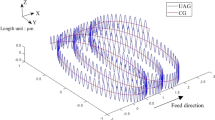Abstract
As grinding force plays an influential role in work-surface finish in grinding process, a model is necessary for optimizing input variables to achieve high product quality and productivity. However, to the best of our knowledge, there are few reports on modeling grinding force in ultrasonic assisted internal grinding (UAIG). In this study, a theoretical model is presented to predict the grinding force in UAIG of SiC ceramics. This model stems from undeformed chip length resulting from the relative motion between the grinding wheel and the workpiece. After analyzing the cutting action of an active individual grain, normal and tangential force models for the UAIG of SiC ceramics are developed. Using the developed model, the influence of many principal input variables, namely the workpiece rotational speed n w , the wheel infeed rate V c , the wheel rotational speed n g , the UV amplitude A u , and the oscillation frequency f o , on grinding force is predicted. Comparing the predicted forces with the experimental ones, it is shown that the predicted forces agree reasonably well with the experimental ones. The obtained results show that (1) the grinding forces are reduced in the UAIG compared to conventional internal grinding, which is attributed to the formation of the longer undeformed chip length in the UAIG; (2) the influence of n g , n w , and V c on grinding force are much pronounced, whereas that of A u and f o are not very noticeable; and (3) the force reduction of UV can be enhanced either by decreasing n g , n w , and V c or increasing A u and f o .
Similar content being viewed by others
References
Nomura M (2007) Study of ultrasonic vibration assisted internal grinding of small holes. Doctoral Dissertation, Tohoku University
Peng Y, Wu YB, Liang ZQ, Guo YB, Lin X (2011) An experimental study of ultrasonic vibration-assisted grinding of polysilicon using two-dimensional vertical workpiece vibration. Int J Adv Manuf Technol 54(9–12):941–947
Peng Y, Liang Z, Wu Y, Guo Y, Wang C (2012) Effect of vibration on surface and tool wear in ultrasonic vibration-assisted scratching of brittle materials. Int J Adv Manuf Technol 59(1–4):67–72
Peng Y, Liang Z, Wu Y, Guo Y, Wang C (2012) Characteristics of chip generation by vertical elliptic ultrasonic vibration-assisted grinding of brittle materials. Int J Adv Manuf Technol 62(5–8):563–568
Junichiro K, Yoshihisa I (1961) Study on ultrasonic internal grinding by using the longitudinally vibrated grinding wheel: 2nd report, the outline of the effects. Trans Jpn Soc Mech Eng 27(181):1412–1418
Wu Y, Nomura M, Kato M, Tachibana T (2003) Fundamental investigation of internal ultrasonic vibration assisted grinding of small holes. Proceedings of International Conference on Leading Edge Manufacturing in 21st century : LEM21, 2003: 145–150
Fujimoto M, Wu Y, Cao J (2011) High Precision Ultrasonically Assisted Internal Grinding (UAIG) of Difficult-to-machining Materials using Metal Bonded Diamond Wheels, Proceedings of The 6th International Conference on Leading Edge Manufacturing in 21st Century, Saitama, Japan, 2011
Cao Jianguo, W Yongbo, L Dong, Fujimoto M, Mitsuyoshi N (2014) Fundamental machining characteristics of ultrasonic assisted internal grinding of SiC ceramics. Mater Manuf Process 29(5):557–563
Cao Jianguo, W Yongbo, L Dong, Fujimoto M, Mitsuyoshi N (2014) Material removal behavior in ultrasonic-assisted scratching of SiC ceramics with a single diamond tool. Int J Mach Tools Manuf 79:49–61
Nomura Mitsuyoshi W, Yongbo KM, Toru T, Tsunemoto K (2005) Study of internal ultrasonic vibration assisted grinding of small bore: mechanism of grinding force reduction due to ultrasonic vibration. J Jpn Soc Abras Technol 49(12):691–696 (In Japanese)
Keita S, Takumi T, Nobuhito Y, Jiwang Y, Tsunemoto K (2009) Ultrasonic-assisted micro-grinding with electroplated diamond wheels. J Jpn Soc Abras Technol 53(1):45–48 (In Japanese)
Qin N, Pei ZJ, Treadwell C, Guo DM (2009) Physics-based predictive cutting force model in ultrasonic-vibration-assisted grinding for titanium drilling. J Manuf Sci Eng 131(4):041001-1–041001-9
Yan W, Bin L, Xiaofeng Z (2014) Research on the system matching model in ultrasonic vibration-assisted grinding. Int J Adv Manuf Technol 70(1–4):449–458
Kun L, Warren L (1997) Modelling of ceramic grinding processes Part I. Number of cutting points and grinding forces per grit. J Mater Process Technol 65(1):1–10
Syoji K (2004) Grinding manufacturing. Yokendo, Tokyo
Arfken G (1984) University physics. Academic, Massachusetts
Sanjay A, Venkateswara RP (2013) Predictive modeling of force and power based on a new analytical undeformed chip thickness model in ceramic grinding. Int J Mach Tools Manuf 65:68–78
Author information
Authors and Affiliations
Corresponding author
Rights and permissions
About this article
Cite this article
Cao, J., Wu, Y., Li, J. et al. A grinding force model for ultrasonic assisted internal grinding (UAIG) of SiC ceramics. Int J Adv Manuf Technol 81, 875–885 (2015). https://doi.org/10.1007/s00170-015-7282-0
Received:
Accepted:
Published:
Issue Date:
DOI: https://doi.org/10.1007/s00170-015-7282-0



